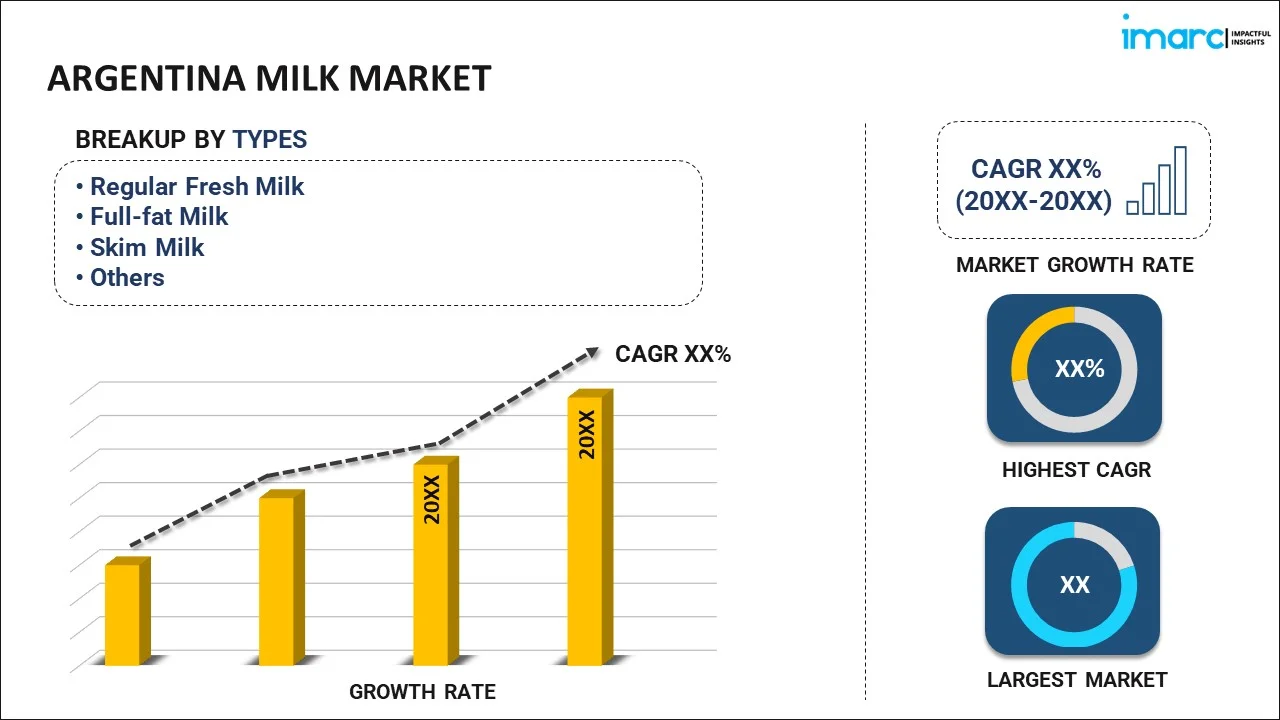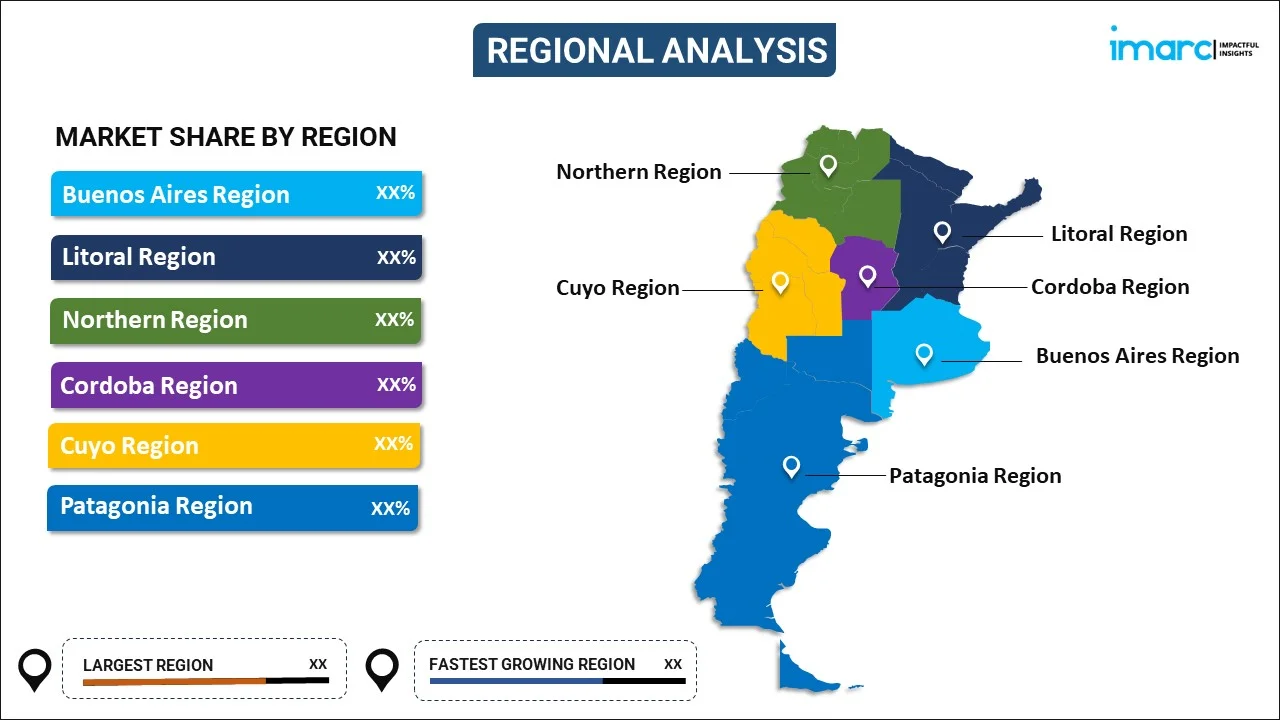
Argentina Milk Market Report by Type (Regular Fresh Milk, Full-fat Milk, Skim Milk, Semi-skim Milk, Flavored Milk, Lactose-free Milk), Distribution Channel (Online, Offline), and Region 2025-2033
Argentina Milk Market Overview:
The Argentina milk market size reached 11.2 Billion Litres in 2024. Looking forward, IMARC Group expects the market to reach 18.2 Billion Litres by 2033, exhibiting a growth rate (CAGR) of 5.1% during 2025-2033. The market is growing mainly driven by increased production of milk, the rising demand for organic and specialty products and technological advancements in farming. The market growth is driven both domestically and through exports with consumers seeking healthier and sustainable options like semi-skimmed and lactose-free milk, which, in turn, aiding in the expansion of overall dairy industry.
|
Report Attribute
|
Key Statistics
|
|---|---|
|
Base Year
|
2024 |
|
Forecast Years
|
2025-2033
|
|
Historical Years
|
2019-2024
|
| Market Size in 2024 | 11.2 Billion Litres |
| Market Forecast in 2033 | 18.2 Billion Litres |
| Market Growth Rate (2025-2033) | 5.1% |
Argentina Milk Market Trends:
Increase in Milk Production
Argentina's milk production is experiencing a notable increase, driven by significant advancements in technology and enhanced farming practices. The adoption of automated milking systems and precision farming techniques has improved the efficiency of milk production, allowing farmers to manage herds more effectively and optimize milk yield. For instance, GEA's DairyRobot now features a master-secondary configuration that allows up to eight boxes to be connected to a single main milk line and up to 16 boxes to one tank resulting in significant energy and water savings in multi-robot installations. These technological improvements are complemented by better feed management and breeding practices, contributing to higher quality and quantity of milk. This surge in production is well-positioned to meet the growing domestic demand for milk and dairy products. Consumers are increasingly aware of the nutritional benefits of milk, leading to higher consumption rates. Additionally, the expansion of the dairy sector is opening up export opportunities. The focus on export growth is further supported by competitive pricing and the high quality of Argentine milk, making it an attractive option for foreign markets. The overall growth in milk production not only boosts the domestic dairy industry but also enhances Argentina's role in the global dairy market.
Rising Demand for Organic and Specialty Milk
In Argentina, the demand for organic and specialty milk products, including semi-skimmed and lactose-free options, is steadily increasing. This trend is driven by consumers' growing focus on health and wellness, leading them to seek out milk products that are not only nutritious but also produced through natural and sustainable methods. As awareness of the benefits of organic farming practices rises, the market for organic dairy products expands. Producers are responding by diversifying their offerings to meet the needs of health-conscious consumers, which in turn fuels the overall growth of the dairy sector. For instance, The Argentina Orgánica Awards were established as part of the Strategic Plan Argentina Orgánica 2030 to promote the development and adoption of technological innovations in organic production. The awards recognize various actors in the organic value chains such as food producers, SMEs engaged in organic processing, retailers, restaurants and organizations implementing programs for organic production. Additionally, there are special mentions for individuals and enterprises contributing to the promotion and development of organic production. This shift towards healthier options is reshaping the landscape of the Argentine milk market, emphasizing quality and sustainability in dairy production.
Argentina Milk Market News:
- In March 2024, Argentina opened its market to Uruguayan dairy imports and other food items after the Milei administration's decision to exempt Value Added Tax (VAT) on certain products. This move is expected to boost Conaprole's external sales to Argentina and capitalize on its record revenue in Latin America. The list of authorized products for export includes dairy products, beef, poultry, fish, eggs, vegetables, cereals and beverages.
- In April 2023, French dairy company Savencia Fromage & Dairy acquired Argentinian dairy company Sucesores de Alfredo Williner. This move will expand Savencia's portfolio with the addition of the Ilolay brand, known for producing a variety of dairy products. The acquisition aligns with Savencia's growth strategy and strengthens its presence in Argentina.
Argentina Milk Market Segmentation:
IMARC Group provides an analysis of the key trends in each segment of the market, along with forecasts at the country level for 2025-2033. Our report has categorized the market based on type and distribution channel.
Type Insights:

- Regular Fresh Milk
- Full-fat Milk
- Skim Milk
- Semi-skim Milk
- Flavored Milk
- Lactose-free Milk
The report has provided a detailed breakup and analysis of the market based on the type. This includes regular fresh milk, full-fat milk, skim milk, semi-skim milk, flavored milk, and lactose-free milk.
Distribution Channel Insights:
- Online
- Offline
A detailed breakup and analysis of the market based on the distribution channel have also been provided in the report. This includes online, and offline.
Regional Insights:

- Buenos Aires Region
- Litoral Region
- Northern Region
- Cordoba Region
- Cuyo Region
- Patagonia Region
The report has also provided a comprehensive analysis of all the major regional markets, which include Buenos Aires Region, Litoral Region, Northern Region, Cordoba Region, Cuyo Region, and Patagonia Region.
Competitive Landscape:
The market research report has also provided a comprehensive analysis of the competitive landscape. Competitive analysis such as market structure, key player positioning, top winning strategies, competitive dashboard, and company evaluation quadrant has been covered in the report. Also, detailed profiles of all major companies have been provided.
Argentina Milk Market Report Coverage:
| Report Features | Details |
|---|---|
| Base Year of the Analysis | 2024 |
| Historical Period | 2019-2024 |
| Forecast Period | 2025-2033 |
| Units | Billion Litres |
| Scope of the Report | Exploration of Historical and Forecast Trends, Industry Catalysts and Challenges, Segment-Wise Historical and Predictive Market Assessment:
|
| Types Covered | Regular Fresh Milk, Full-fat Milk, Skim Milk, Semi-skim Milk, Flavored Milk, Lactose-free Milk |
| Distribution Channels Covered | Online, Offline |
| Regions Covered | Buenos Aires Region, Litoral Region, Northern Region, Cordoba Region, Cuyo Region, Patagonia Region |
| Customization Scope | 10% Free Customization |
| Post-Sale Analyst Support | 10-12 Weeks |
| Delivery Format | PDF and Excel through Email (We can also provide the editable version of the report in PPT/Word format on special request) |
Key Questions Answered in This Report:
- How has the Argentina milk market performed so far and how will it perform in the coming years?
- What is the breakup of the Argentina milk market on the basis of type?
- What is the breakup of the Argentina milk market on the basis of distribution channel?
- What are the various stages in the value chain of the Argentina milk market?
- What are the key driving factors and challenges in the Argentina milk?
- What is the structure of the Argentina milk market and who are the key players?
- What is the degree of competition in the Argentina milk market?
Key Benefits for Stakeholders:
- IMARC’s industry report offers a comprehensive quantitative analysis of various market segments, historical and current market trends, market forecasts, and dynamics of the Argentina milk market from 2019-2033.
- The research report provides the latest information on the market drivers, challenges, and opportunities in the Argentina milk market.
- Porter's five forces analysis assist stakeholders in assessing the impact of new entrants, competitive rivalry, supplier power, buyer power, and the threat of substitution. It helps stakeholders to analyze the level of competition within the Argentina milk industry and its attractiveness.
- Competitive landscape allows stakeholders to understand their competitive environment and provides an insight into the current positions of key players in the market.
Need more help?
- Speak to our experienced analysts for insights on the current market scenarios.
- Include additional segments and countries to customize the report as per your requirement.
- Gain an unparalleled competitive advantage in your domain by understanding how to utilize the report and positively impacting your operations and revenue.
- For further assistance, please connect with our analysts.
 Request Customization
Request Customization
 Speak to an Analyst
Speak to an Analyst
 Request Brochure
Request Brochure
 Inquire Before Buying
Inquire Before Buying




.webp)




.webp)












